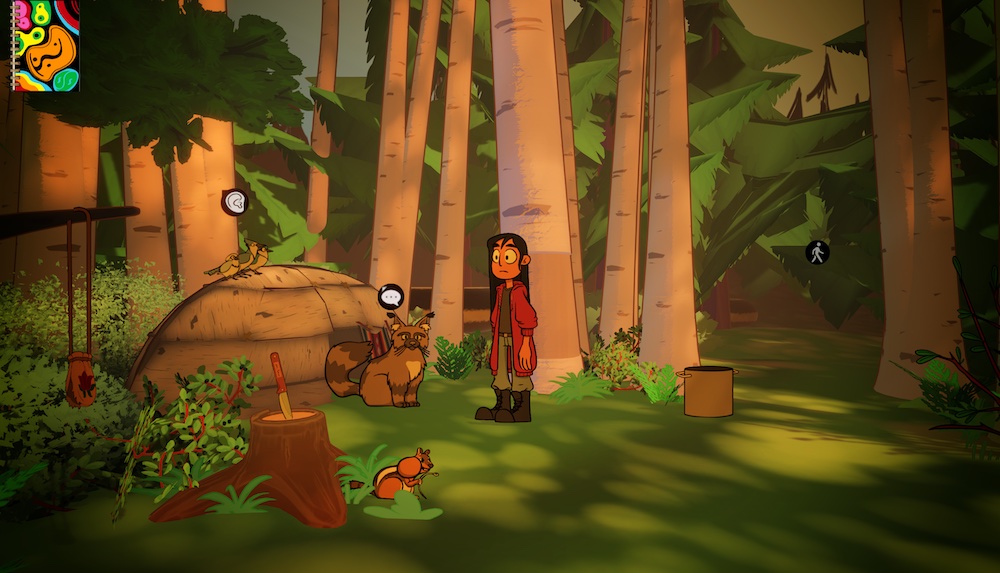
- Details
- By Chez Oxendine
- Arts and Culture
Warm, orange sunlight dapples the forest floor, illuminating a scene of an Ojibwe youth in a red hoodie. Perched nearby, a talking cat chimes in with a warning: don’t give your real name too freely in the forest.
That’s the opening screen of Reclaim!, a point-and-click video game by Minnesota-based Grassroots Indigenous Multimedia (GIM). The game could prove a valuable tool in teaching and preserving the Ojibwe language, says Dr. Mary Hermes, a member of the Lac Courte Oreilles tribal community and the nonprofit group’s director.
The game’s name — Reclaim! — emphasizes the group’s purpose of reclaiming the Ojibwe language from decline and re-establishing it as a vibrant part of the Ojibwe community.
The scene in the forest is the first level from the game’s most recent demo. Players are tasked with solving puzzles and speaking with other characters, while learning Ojibwe stories and language. It’s a distinct departure from games that pit players against each other, Hermes said.
“Most games are very colonial, they're about conquering somebody, fighting somebody, " Hermes told Tribal Business News. “This is our attempt to break into our market and have our voice in Ojibwe present in games. People are responding well to it.”
Video games represent the fastest-growing form of entertainment around the world. The global market for video games stood at $217 billion in 2022, per a report by analysts Grandview Research. By 2030, that market size should more than double to $584 billion.
It’s where people go for entertainment, and it’s where they’re finding their stories, Hermes said.
“I thought of this a long time ago because I thought about my children, how they were getting stories,” Hermes said. “I know it’s the fastest-growing medium out there.”
The game, which will be available for play on PCs and tablets, has a targeted January 2026 release. GIM’s chief customers will likely be schools, libraries, and other institutions rather than individual gamers, Hermes said. The game isn’t being made for profit, but GIM wants to earn enough on the game to continue updating and expanding the project.
“We’re thinking mostly of schools who would buy the game to keep the updates going and migrate us forward,” Hermes said. “Then there’s the potential that the next thing we do is put it on another platform. That’s next on the list if we get that far.”
Most of the game’s funding stems from grant awards. The game began with a $350,000 educational research grant from the New York City-based Spencer Education Foundation, a nonprofit that invests in education research. Hermes recalls believing that amount would be plenty to develop a video game. She’s since learned that isn’t the case: art and voice costs alone have quickly racked up expenses.
More recently, Reclaim! caught the attention of MIT’s Indigenous Communities Fellowship Program, which awarded Hermes a fellowship in 2022. That came with $10,000 and networking support.
Additional funding has come from a literacy grant from the Department of Education to the St. Paul Public School District.
With funding secured, the project is being developed in partnership with the University of Minnesota, where Dr. Hermes is a faculty member. The project team includes writers, artists, sound designers, and of course, Ojibwe speakers. Artist Josh Herron, one of the people working on the project, called Reclaim! one of his favorite projects.
“Reclaim! is a totally different project than anything I’ve ever worked on in so many ways. I have never worked on a project that was less of a ‘product’ and more of a community good. That difference lines up so much with what I believe art should be,” Herron said. “This is for Natives, by Natives.”
That’s by design, Hermes said: the team went out of its way, even when it was challenging, to hire Indigenous staff.
Games writing, art, and coding all suffer the same dearth of Indigenous representation as the rest of the tech industry. That made finding staff difficult, but networking through events like the annual Game Developers Conference helped pinpoint the right people.
“It has been challenging, because we'll have people who know about the game who maybe don't have exactly the skills. It's just a lot of different, distinct skills you have to piece together and you have to find the right people,” Hermes said. “We worked long and hard to pull together Native people who said, ‘I can't believe you're doing this, let me play.’”
Now, development for the game enters its final stretch. The next two years involve playtesting, then fine-tuning and expanding existing content in response, Hermes said. So far, people have enjoyed what they have played of the game, even if it’s just the first level.
That leaves the question of whether or not it will work as a method of teaching people how to speak the Ojibwe language, Hermes said. There’s only one way to find out.
“We’re breaking into this medium to make learning Ojibwe fun (in a way that is) different than anything we have. We have immersion schools, and ceremonies, but we don’t really have anything in this domain,” Hermes said. “It’s supposed to be fun, so we have a fun place to use Ojibwe. I just hope the fun translates into using the language.”
